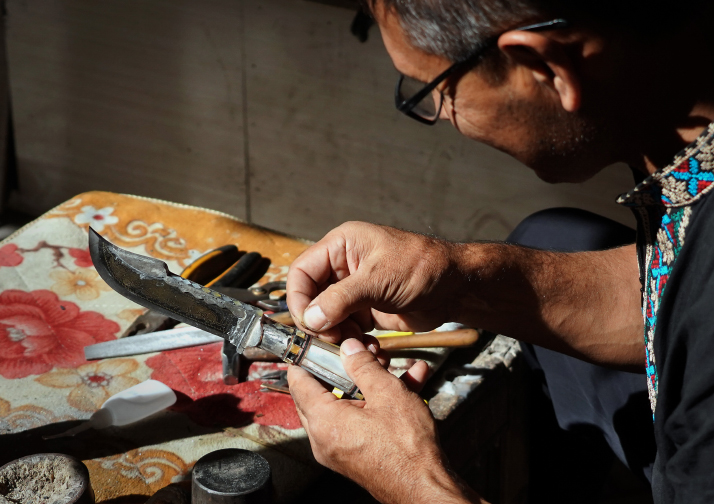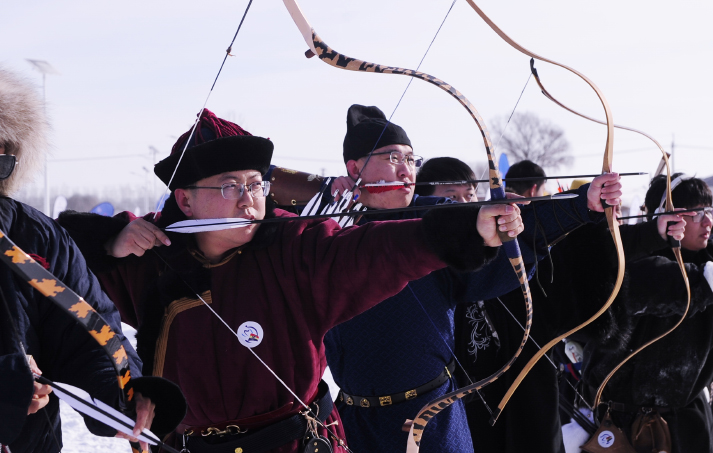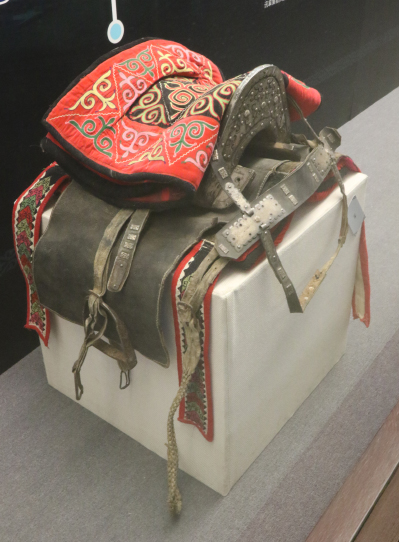| Xinjiang Today |
| Legacy with an edge | |
|
|
 An artisan carefully crafts a knife in Yingjisha County, Kashi Prefecture, on September 5, 2023 (XINHUA)
After two decades of perfecting his craft, Aisan Yimier finally established his own knife-making workshop last year in Yingjisha (Yengisar) County, located in Kashi Prefecture, in the southern part of Xinjiang Uygur Autonomous Region. Though only in his mid-30s, this local Uygur artisan has spent over 20 years mastering the ancestral techniques for forging the region's iconic knives—a skill he began honing as a child in this desert oasis where the rhythmic clang of hammers has resonated through generations. With a history spanning more than four centuries, Yingjisha knives originated as indispensable tools for local herders and farmers to carve meat, whittle wood, and even slaughter livestock. Over time, their handles evolved from practical grips into works of art. Art on knives Yingjisha County is home to over 1,000 knife-makers. In this land where metalworking skills flow through families like genetic code, Aisan grew up immersed in the craft. In Kalabashilangan Village, known as the "Knife Village" in Yingjisha, more than 80 percent of households are engaged in the production and sale of knives. Here, visitors can closely observe the entire process of knife-making. Aisan's workshop is located in this village. The process of creating a Yingjisha knife is meticulous. It begins with selecting the finest steel, followed by hours of hammering, shaping and sharpening. Creating a single Yingjisha knife involves 29 distinct steps, each carefully executed by hand—from forging the steel to engraving delicate motifs. Every stage requires intense focus, skill and patience, reflecting the artisan's unwavering dedication to their craft. Yingjisha knives, typically ranging from 11 to 12 cm in length, can vary considerably in size, with the longest exceeding half a meter, while the shortest measuring around 5 cm. These knives come in diverse designs inspired by nature and culture, including the crescent moon, the phoenix tail, eagles and lark heads. A standard knife costs between tens to hundreds of yuan (a couple to tens of U.S. dollars), while finely crafted ones fetch thousands or even tens of thousands of yuan (hundreds or thousands of U.S. dollars). In recent years, visitors to Yingjisha have marveled at a gold-encrusted knife priced at 128,000 yuan ($1,800), crafted in 2022 by Aisan. This award-winning piece features a pure gold handle intricately engraved with patterns and inlaid with precious stones such as Hetian (Hotan) jade and turquoise. It earned Aisan the top prize at the Yingjisha Knife Craft Competition in 2022. He is one of the few artisans in Yingjisha with the skill to create such gold knives. Hai Yanyi, a woman who moved from Urumqi, capital city of Xinjiang, to Yingjisha seven years ago to explore business opportunities in these knives, explained that local artisans are categorized into three tiers: craftsmen, artisans and master artisans. There are approximately 70-80 artisans and fewer than 10 master artisans among the over 1,000 people in this trade. Artisans are permitted to engrave their names on their works, while master artisans focus on custom orders for high-end knives, each taking over half a month to complete. "Every knife is handmade and unique, especially those created by master artisans. Each has a distinct style—often recognizable at a glance," Hai told Xinjiang Today. Over the past seven years, she has witnessed growing interest in Yingjisha knives, driven by tourism and the rise of live-commerce, the blending of livestreaming and e-commerce, which has boosted sales and awareness. Hai is preparing to expand into overseas e-commerce platforms to introduce these cultural treasures to global audiences.  People in Shenyang City, Liaoning Province in northeast China, take part in a Xibe archery competition in January 2024 (VCG)
Preserving tradition In 2008, the Uygur traditional knife-making craftsmanship of Yingjisha was inscribed into China's National Intangible Cultural Heritage List. Xinjiang, a region home to many ethnic groups, boasts a wealth of such heritage. Many minority communities, shaped by centuries of nomadic life, have developed unique artisanal traditions recognized for their cultural significance. Among these is the archery craftsmanship of the Xibe ethnic group, also listed as national intangible cultural heritage in 2008. The Xibe people, renowned for horseback archery, migrated from northeast China to the Ili River Valley in Xinjiang in the 1760s. Over 4,000 Xibe settlers relocated to guard the frontier, relying on bows and arrows for hunting and warfare. Archery became an essential skill for Xibe men, evolving into both a practical tool and an art form. Yi Chenyong, a 55-year-old Xibe craftsman from Chabuchaer (Qapqal) Xibe Autonomous County (known as "China's Arrow Hometown"), inherited this tradition from his father, Yi Chunguang, a national intangible cultural heritage inheritor. Yi began assisting his father in bow-making in 1990. Yi Chenyong introduced that a traditional Xibe bow measures 1.6 meters in length and weighs nearly 1 kg. Crafting one involves many specialized tools and steps, including cutting, sawing, planing and decorating. The process demands meticulous material preparation, drying, shaping and assembly. To research and promote this intangible cultural heritage, Yi Chenyong and his father founded the Xibe Traditional Bow-Making Workshop in 2003 and got involved in the establishment of China's first archery-themed museum—the Chinese Archery Culture Museum—opened in Chabuchaer in 2012. Yi Chenyong, who has trained seven apprentices, emphasizes holistic education: His teachings span both bow-making techniques and archery skills. He also organizes workshops at schools and tourist sites to broaden public engagement. For him, reviving and passing down these ancient crafts are about more than preserving technical skills—they are about ensuring the survival of traditional archery and its cultural spirit.  A Kazak saddle (VCG)
While the Xibe archery tradition underscores one facet of Xinjiang's cultural richness, another nomadic group—the Kazak people—saw their saddle-making technique added to Xinjiang's Regional Intangible Cultural Heritage List in 2020. Kazak saddles, among the earliest developed on the Eurasian steppes, epitomize the nomadic ethos of mobility, resilience and artistry. Historically essential for survival on horseback, these saddles evolved over centuries as artisans refined their designs to harmonize practicality with aesthetic brilliance, integrating techniques like metal casting, woodcarving, embroidery and leatherwork. This recognition not only celebrates the craft's historical significance but also acknowledges its enduring role in Kazak identity. Unlike mass-produced equivalents, each saddle is a testament to the maker's mastery of multiple disciplines—from selecting durable materials to sculpting ergonomic forms tailored to individual riders. Samit Azil, a 73-year-old saddle craftsman from a village in Altay Prefecture, has practiced this craft since 1980, learning from his father and grandfather. Now a third-generation master, he adheres strictly to traditional methods. Eschewing molds or machines, he relies on keen observation of a rider's height and weight to create comfortable, custom saddles. "Making a saddle requires mastery of blacksmithing, leather braiding and carpentry. I've learned all three skills to work independently. If one skill falters, I'd need help," Samit told China News Service. He personally selects materials, from wood to cattle hide, ensuring quality. He started selling saddles in 1990. Back then, he could craft 13-14 saddles each winter, priced at just 150-200 yuan ($20-27) each. Through persistent effort, his client base grew steadily. "Now, each saddle sells for an average of 1,500 yuan ($200)," he said. "These saddles have brought my family more than just financial gain—they've brought us happiness and fulfillment." Comments to yuanyuan@cicgamericas.com |
|
||||||||||||||||||||||||||||
|